Atomic layer deposited Al2O3 coatings on SUS 310S stainless steel
IF 5.3
2区 材料科学
Q1 MATERIALS SCIENCE, COATINGS & FILMS
引用次数: 0
Abstract
Atomic layer deposition (ALD) is a technique capable of forming ultra-thin, uniform, and high-quality films on the surface of various materials. The Al2O3 coatings are an ideal choice for protecting stainless steel from high-temperature oxidation and chemical corrosion. In this work, Al2O3 coatings with a thickness of approximately 150 nm were prepared on the surface of 310S stainless steel using improved ALD technology. The results found that, firstly, the oxidation rate of Al2O3 coating samples (3.03×10−12 g2·cm−4·s−1) decreased by an order of magnitude compared with the matrix (1.55 × 10−11 g2·cm−4·s−1). Secondly, after oxidation in air at 1200 °C for 50 h, the Cr element content on the surface of the matrix and the Al2O3 coating samples is 40.27 % and 9.67 %, respectively. Finally, the corrosion current density corroded in 3.5 wt% NaCl solution and 0.1 mol·L−1 H2SO4 solution of Al2O3 coating samples (1 × 10−5 and 5 × 10−4 mA/cm2, respectively) was significantly decreased compared with the matrix (1 × 10−4 and 1 × 10−2 mA/cm2, respectively). The above results concluded that the Al2O3 coatings prepared by ALD technology can significantly enhance the high-temperature oxidation resistance, Cr resistance, and corrosion resistance of the 310S matrix.

求助全文
约1分钟内获得全文
求助全文
来源期刊

Surface & Coatings Technology
工程技术-材料科学:膜
CiteScore
10.00
自引率
11.10%
发文量
921
审稿时长
19 days
期刊介绍:
Surface and Coatings Technology is an international archival journal publishing scientific papers on significant developments in surface and interface engineering to modify and improve the surface properties of materials for protection in demanding contact conditions or aggressive environments, or for enhanced functional performance. Contributions range from original scientific articles concerned with fundamental and applied aspects of research or direct applications of metallic, inorganic, organic and composite coatings, to invited reviews of current technology in specific areas. Papers submitted to this journal are expected to be in line with the following aspects in processes, and properties/performance:
A. Processes: Physical and chemical vapour deposition techniques, thermal and plasma spraying, surface modification by directed energy techniques such as ion, electron and laser beams, thermo-chemical treatment, wet chemical and electrochemical processes such as plating, sol-gel coating, anodization, plasma electrolytic oxidation, etc., but excluding painting.
B. Properties/performance: friction performance, wear resistance (e.g., abrasion, erosion, fretting, etc), corrosion and oxidation resistance, thermal protection, diffusion resistance, hydrophilicity/hydrophobicity, and properties relevant to smart materials behaviour and enhanced multifunctional performance for environmental, energy and medical applications, but excluding device aspects.
 求助内容:
求助内容: 应助结果提醒方式:
应助结果提醒方式:


